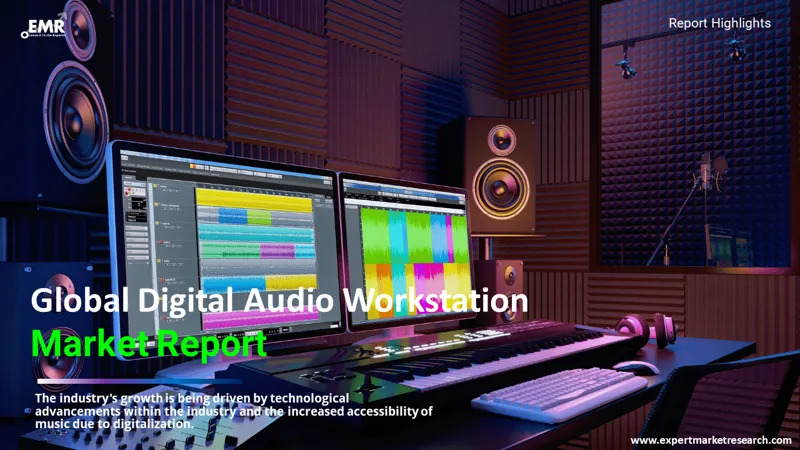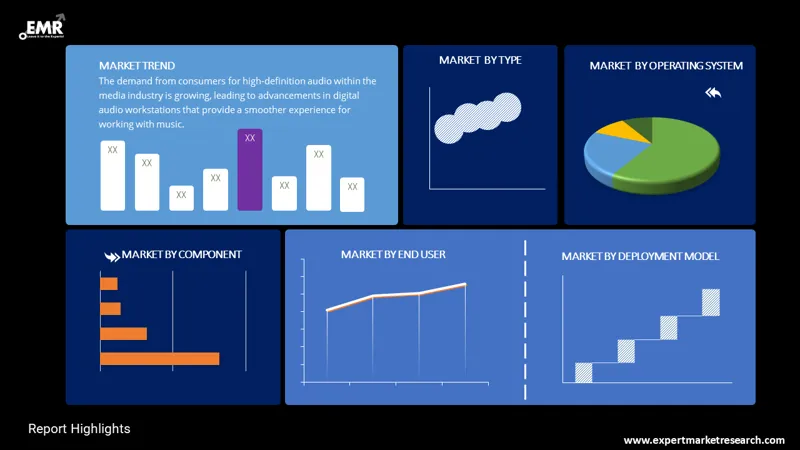
Consumer Insights
Uncover trends and behaviors shaping consumer choices today
Procurement Insights
Optimize your sourcing strategy with key market data
Industry Stats
Stay ahead with the latest trends and market analysis.
The global market for digital audio workstation reached about USD 3.61 Billion in 2025. The market is expected to grow at a CAGR of about 7.80% in the forecast period of 2026-2035. It will reach an approximate value of USD 7.65 Billion by 2035, driven by the increasing demand for high-definition media.
Base Year
Historical Period
Forecast Period
Compound Annual Growth Rate
7.8%
Value in USD Billion
2026-2035
*this image is indicative*
North America has been leading the global market for digital workstations since the historical period. It will continue to show its dominance during the forecast period as well, owing to the increasing adoption of advanced technologies, including Android, Linux, and other operating systems, and the rising digitisation of the music industry. Due to the technological advancements and digitisation of music instruments, the production process has become smoother with each step, and the entertainment industry is progressively moving towards digital audio workstations as the need for music production of higher quality rises with the growing number of shows, internet videos, games, film scores, and others.

Read more about this report - REQUEST FREE SAMPLE COPY IN PDF
The established players in North America also incorporate AI and Cloud-based systems to increase the scale and functionality. It offers reduced cost and easy integration, provides pre-composed genre models and enables processing, importing, and exporting in any file format, making organisations much more manageable and raising the adoption of digital audio workstations.
Digital Audio Workstation (DAW) is an electric device or music production software used to record computer audio. It works on both MAC and Windows, allowing the user to record, manipulate different aspects of music, and create audio files.
Breakup by Component
Breakup by Type
Breakup by Operating System
Breakup by End User
Breakup by Deployment Model
Breakup by Region

Read more about this report - REQUEST FREE SAMPLE COPY IN PDF
The consumer’s demand for high-definition audio from the media industry is increasing. To meet the requirements, digital audio workstations are advancing fast to provide a smoother experience while working with music. Digitisation has made it much easier to buy and access music, all it needs is a few clicks, and it is available in the device's music library. Technological advancement has also made it possible to stream music on devices, it can be played from anywhere in the world, and it does not cover much of the storage space, making it significantly user-friendly, which further promotes the market growth of digital audio workstations.
Presently, digital audio workstations are being used almost in audio and video processing systems, and the user base is continuously growing due to the sheer accessibility it provides. It also lowers the entry barrier for budding professionals. It gives music producers, DJs, audio engineers, and professionals the ability to hold live performances more efficiently and work on the fly; because of this, the Android-based systems and application software are gaining popularity, especially in the Asia Pacific region, which compliments the growth of the market in the region.
The report gives a detailed analysis of the following key players in the global digital audio workstations market, covering their competitive landscape, capacity, and latest developments like mergers, acquisitions, and investments, expansions of capacity, and plant turnarounds:
The comprehensive EMR report provides an in-depth assessment of the market based on the Porter's five forces model along with giving a SWOT analysis.




*While we strive to always give you current and accurate information, the numbers depicted on the website are indicative and may differ from the actual numbers in the main report. At Expert Market Research, we aim to bring you the latest insights and trends in the market. Using our analyses and forecasts, stakeholders can understand the market dynamics, navigate challenges, and capitalize on opportunities to make data-driven strategic decisions.*
Get in touch with us for a customized solution tailored to your unique requirements and save upto 35%!
In 2025, the global market attained a value of nearly USD 3.61 Billion.
The market is projected to grow at a CAGR of 7.80% between 2026 and 2035.
The market is estimated to witness healthy growth in the forecast period of 2026-2035 to reach USD 7.65 Billion by 2035.
The industry is driven by the technologically advancing industry and the accessibility provided by the digitisation of music.
The primary industry trend is the changing generation and increasing adoption of digital music.
The major regions in the industry are North America, Europe, Asia Pacific, Latin America, the Middle East, and Africa, with North America being a dominant region for the market.
The components in the market are software and services, where services can be further divided into professional and managed.
The types of global digital audio workstations include Editing, Mixing, and Recording.
The operating systems used are Android, Mac, Windows, and Linux.
The end-users in the market include artists/performers, education institutes, music studios, professionals/audio engineers and mixers, songwriters and production teams, and electronic musicians, among others.
The primary end-users of the digital audio workstation industry are professionals/ audio engineers and mixers.
The deployment models of the digital audio workstations market include on-premises and cloud.
The major players in the industry are Apple Inc., Adobe Inc., Ableton AG, Steinberg Media Technologies GmbH, Acoustica Inc., and PreSonus Audio Electronics, Inc., among others.
Explore our key highlights of the report and gain a concise overview of key findings, trends, and actionable insights that will empower your strategic decisions.
| REPORT FEATURES | DETAILS |
| Base Year | 2025 |
| Historical Period | 2019-2025 |
| Forecast Period | 2026-2035 |
| Scope of the Report |
Historical and Forecast Trends, Industry Drivers and Constraints, Historical and Forecast Market Analysis by Segment:
|
| Breakup by Component |
|
| Breakup by Type |
|
| Breakup by Operating System |
|
| Breakup by End User |
|
| Breakup by Deployment Model |
|
| Breakup by Region |
|
| Market Dynamics |
|
| Competitive Landscape |
|
| Companies Covered |
|
| Report Price and Purchase Option | Explore our purchase options that are best suited to your resources and industry needs. |
| Delivery Format | Delivered as an attached PDF and Excel through email, with an option of receiving an editable PPT, according to the purchase option. |
Datasheet
One User
USD 2,499
USD 2,249
tax inclusive*
Single User License
One User
USD 3,999
USD 3,599
tax inclusive*
Five User License
Five User
USD 4,999
USD 4,249
tax inclusive*
Corporate License
Unlimited Users
USD 5,999
USD 5,099
tax inclusive*
*Please note that the prices mentioned below are starting prices for each bundle type. Kindly contact our team for further details.*
Flash Bundle
Small Business Bundle
Growth Bundle
Enterprise Bundle
*Please note that the prices mentioned below are starting prices for each bundle type. Kindly contact our team for further details.*
Flash Bundle
Number of Reports: 3
20%
tax inclusive*
Small Business Bundle
Number of Reports: 5
25%
tax inclusive*
Growth Bundle
Number of Reports: 8
30%
tax inclusive*
Enterprise Bundle
Number of Reports: 10
35%
tax inclusive*
How To Order

Select License Type
Choose the right license for your needs and access rights.

Click on ‘Buy Now’
Add the report to your cart with one click and proceed to register.

Select Mode of Payment
Choose a payment option for a secure checkout. You will be redirected accordingly.
Gain insights to stay ahead and seize opportunities.

Get insights & trends for a competitive edge.

Track prices with detailed trend reports.

Analyse trade data for supply chain insights.

Leverage cost reports for smart savings

Enhance supply chain with partnerships.

Connect For More Information
Our expert team of analysts will offer full support and resolve any queries regarding the report, before and after the purchase.
Our expert team of analysts will offer full support and resolve any queries regarding the report, before and after the purchase.
We employ meticulous research methods, blending advanced analytics and expert insights to deliver accurate, actionable industry intelligence, staying ahead of competitors.
Our skilled analysts offer unparalleled competitive advantage with detailed insights on current and emerging markets, ensuring your strategic edge.
We offer an in-depth yet simplified presentation of industry insights and analysis to meet your specific requirements effectively.
Share